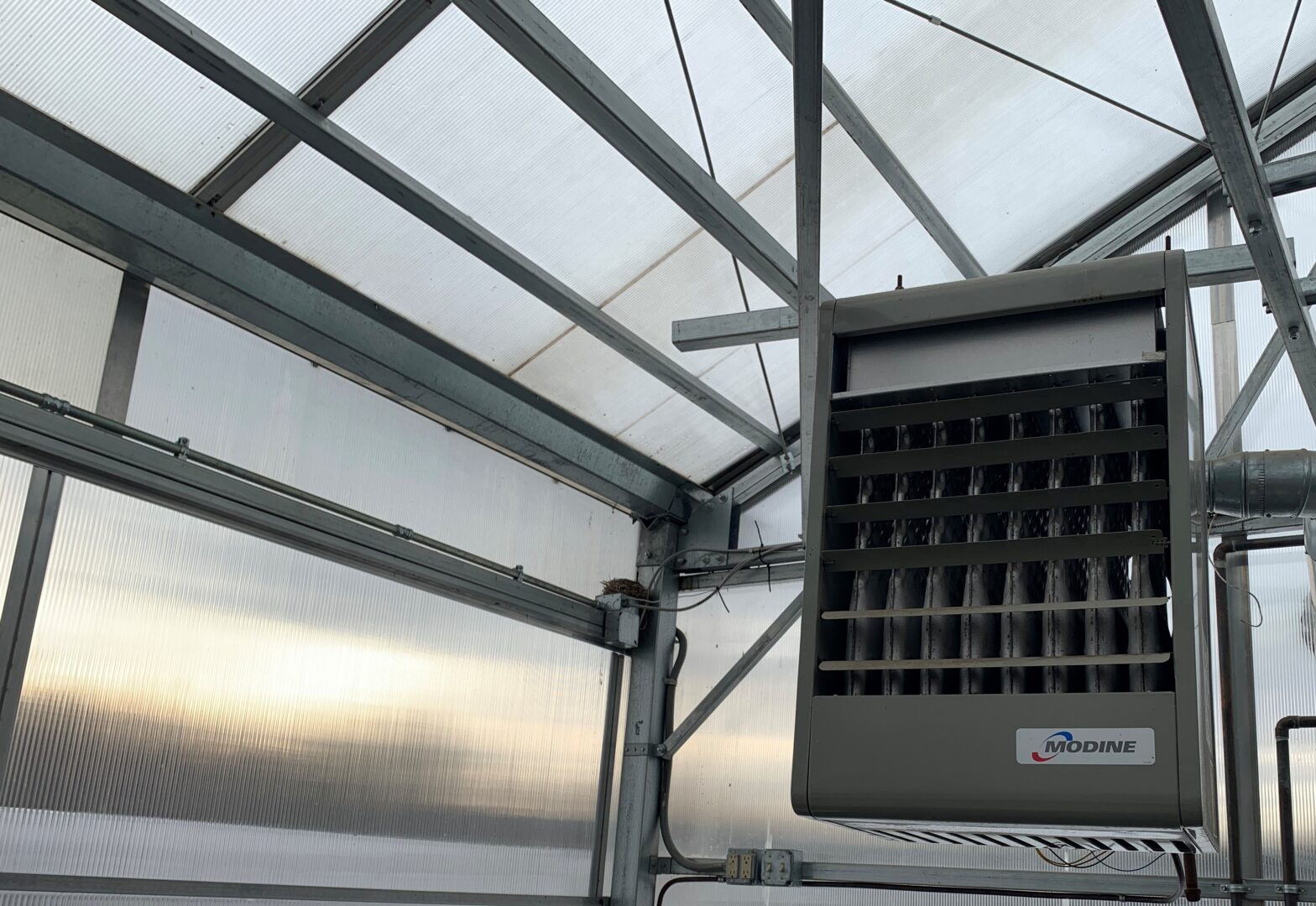As the days grow longer and warmer, we can’t help turning our attention to germination chambers, propagation houses, greenhouses, and high tunnels. It is an exciting time of year, but also a time to take some extra care with heating appliances. Before firing up the heaters in your heated growing spaces, take the time to plan for some preventive maintenance and do a few safety checks. Although this guide is mainly focused on propane heaters due to their wide-spread use, most of checks apply to all heaters.
Preventive Maintenance
Some annual preventive maintenance that growers find helpful include:
- Visually inspect each heater and give it an overall cleaning (see below for examples)
- Run the heater over the winter occasionally to check operation. Use your eyes, ears, and nose to check for things that seem out of the ordinary (see below for examples).
- Start the heater up several weeks before you will need it. There are generally some inevitable repairs and maintenance needed.
- Have a spare parts kit with things that tend to fail or need frequent replacement such as igniters, thermocouples, and seals.
- If this isn’t your comfort zone, hire in a professional heater technician to give your heater a once-over to improve safety, fuel efficiency, and reliability.
Getting to Know Your Heater
Take some time to get familiar with the main parts of your heater. The photos below show the key parts of a common heater. Your heater’s installation and operation manual (IOM) is a handy reference. If you’ve misplaced it, find the manufacturer’s name and model number on the heater. Most manuals are available online at the manufacturer’s website.
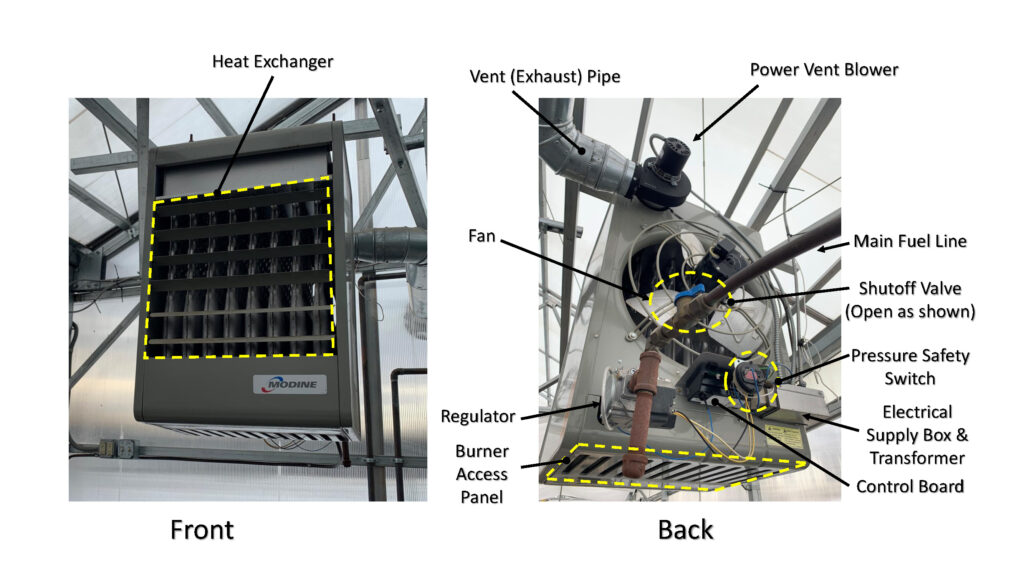

Start-up Checklist
Some of the key things to check are listed below. A more comprehensive checklist is available from Modine and other detailed references are included below.
- Fuel Supply
- Fuel tanks are stable.
- Fuel lines are in good condition.
- Fuel lines are run to avoid being hit or stepped on.
- Fuel tanks valve is open.
- If anything seems amiss with the tanks or main line call your fuel company to have it corrected.
- You should not smell propane when the tank valve is open.
- Fuel Regulator / Valve and Nozzle
- Fuel regulator / valve is free of damage, clear of debris, etc.
- Nozzle(s) are clear of any blockage.
- You should not smell propane.
- Clean Heat Exchanger Inside and Out
- Inside of burner tubes, the heat exchanger, and the exhaust path is open and free of obstructions. This may require removing panels, blowing out with a reversed shop-vac or compressed air and resealing panels.
- Outside of the heat exchanger is clear of any cobwebs or other debris on the.
- Heat exchanger walls are solid and in good condition.
- Exhaust Pipe
- The exhaust pipe is continuously connected from the heater to the outside.
- Replace any sections that have significant signs of corrosion.
- Exhaust termination cap is in place to prevent bird and rodent nesting or other blockage.
- Exhaust is well above snow line and otherwise free of obstruction.
- There is no smoke or soot when the heater is operating.

- Thermostat
- The thermostat is switching on/off at the right temperature.
- The thermostat wire is solidly connected on both ends and is free of nicks, gnaw marks or other damage that could cause a short or open circuit.
- Electronics
- The electronic control board and surrounding area is clean.
- There are no singe marks on the circuit board or wiring.
- The supply wiring is in good condition and run to avoid damage or interference with greenhouse use.
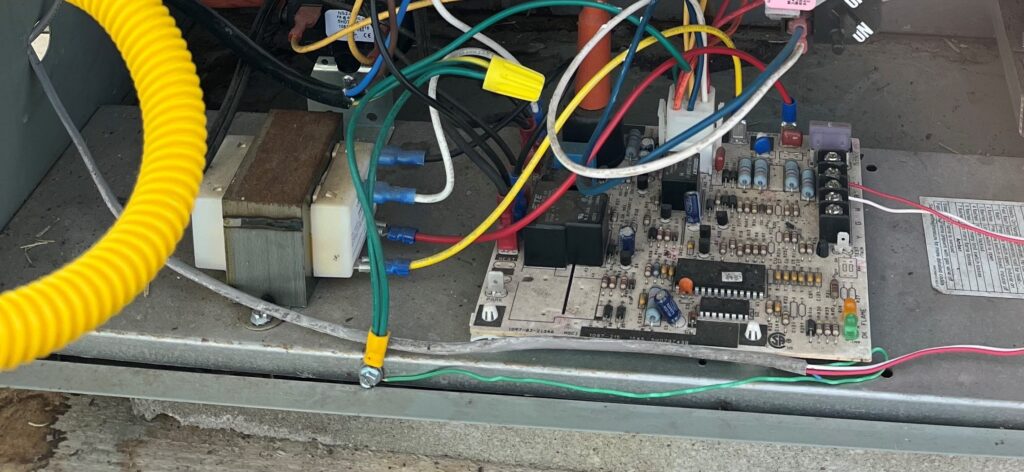
This electronic control board is relatively clean and has no obvious signs of damage. The transformer to the left converts 120 VAC to 24 VAC and also shows no signs of damage.
- Eyes, Ears, and Nose
- Look for any signs of charring, singing, burning, smoke, significant vibration, or other maintenance needs.
- The main noises you should hear are the vent fan (if power vented model) and the heat distribution fan. Loud pops, bangs, or knocking mean something is wrong.
- You should not smell propane.
What Could Go Wrong?
The photos below were provided by a grower who experienced a startup issue. The unit heater had been powered up with the thermostat set very low for winter greens production in the tunnel. It was probably running very infrequently and for short durations. The control panel cover was left off during this time as well.
The grower had just set the thermostat up for some late winter production and sat down for a lunch break. They noticed a burning smell and saw the label on the side of the unit start to be singed. See the video below.
When they took the cover off, the grower noticed that the nice blue flames that are normally contained completely within the burner tubes were yellow and “rolling out” on the bottom two tubes. The flames of a propane unit heater should always be blue and contained within the burner tube and heat exchanger area when operating correctly. Yellow flames are a sign of poor combustion. When the unit was shut down, some residual, yellow flames would remain on the bottom two fuel nozzles.
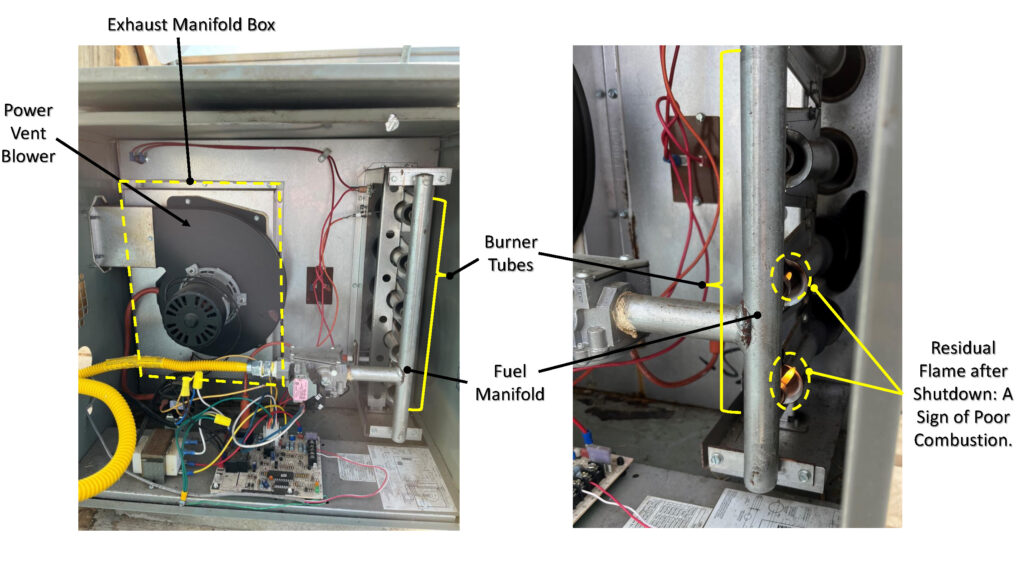
The grower checked the fuel orifices on these two burner tubes and they were clear, so the problem was likely not a fuel delivery issue. The other possibility was a combustion air and exhaust flow issue.
In most propane unit heaters the combustion air is entrained into the burner through the opening between the orifice / nozzle and the burner tube. The flow of the fuel at high velocity causes low pressure around it and brings the combustion air in. In power-vented heaters, this air entrainment is enhanced by the blower that sucks air through the burner tubes and exhausts it out the vent. In order for combustion air to mix well with the fuel to provide complete (and clean) combustion, there needs to be equal and easy flow through all the tubes.
The next thing the grower checked was that the inside of all burner tubes was clear in order to provide easy flow of exhaust and to support good combustion. This required removing the power vent / exhaust manifold box which is a pain, but worth it. Having some replacement seal material on hand will make re-assembly with a proper seal easier.
When the exhaust side of the burner tubes were examined, an obvious blockage was noted with soot in the surrounding area. It appears to have been a mouse nest.
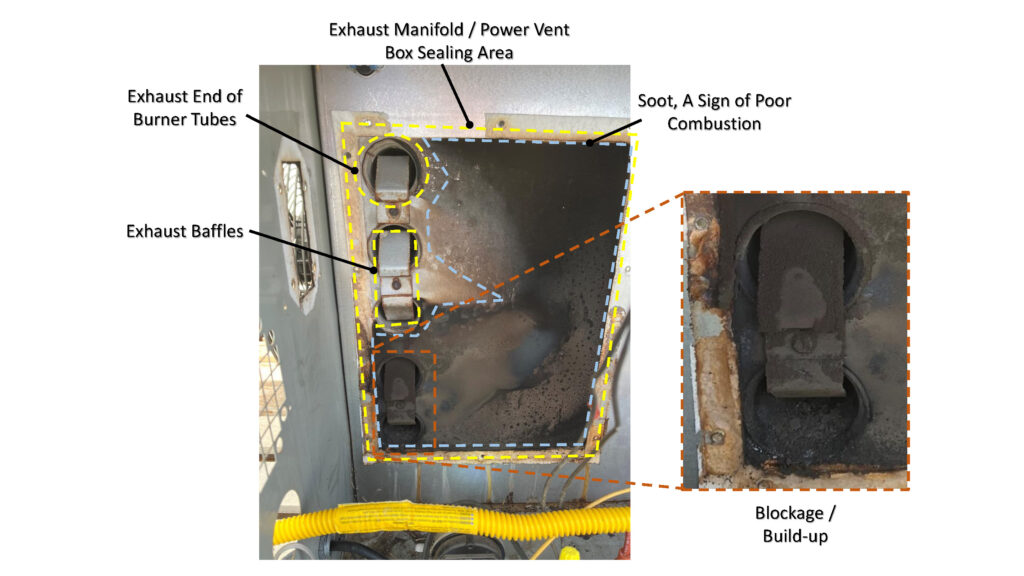
By removing the exhaust baffles the control the flow rate through the tubes and clearing out with a vacuum, the problem was resolved.
Grower Experiences in Their Own Words
Many thanks to the Vermont Vegetable & Berry Growers Association (VVBGA) community for contributing their experiences.
A moth nest in the regulator.
Last winter our heater wouldn’t fire up, it would spark and the fans would start running but no flame. I took almost the whole gas line apart to check for blockages and found nothing. Called a tech and he found a moth had built a nest inside the gas valve. Cleared it out and we were back in business. I set a recurring calendar appointment to fire up the heater for a few minutes once a month now. I probably follow through about half the time, but no problems since then!
Preventative blow-out of the heater tubes.
I always blow out the exchanger tubes before starting up. Blockage leads to flame roll-out and will ruin the orifice the propane comes out of if it isn’t burning properly. Also check the vacuum tube on the safety switch that controls the power vent.
Not my jam! Hire in the experts.
I definitely hire a professional to come out and do it. Propane stresses me out!
Check them out early, plan for repairs. Have a spare parts kit. Lean on the experts.
We check our heaters before using them with a quick look at the burners to make sure they are burning well. The burners can be easily cleaned with a wire brush and or compressed air. We always make sure to watch the heaters function for a while if we have not fired them up recently. We do have the propane techs come out if it is anything beyond that generally speaking. I know some farmers do some of their own propane work and service their heaters. I think unless it is an emergency it is good to have your propane company do it for liability reasons. I keep a box of spare heater parts on hand, extra burners, control panel, fans etc. The total cost was around $500, which seems like cheap insurance to me.
Watch for heater tube blockage.
We did have troubles with our heater this winter in our current washing area which is also our seedling house. The burner, which is a little old, got clogged with oxidized metal from the burner itself. To look at it, it seemed fine, but it was blocking the flow enough that it was allowing propane to build up and make a small explosion every so often. We had been running that heater on and off when we were in there packing. No real issues, just a little startling it was an easy fix for the propane tech.
Add a relay to prevent heater and vent fans from running at the same time.
Another thing to note: maybe other growers do this but I had never seen it on farms I worked for. Our propane company makes us install a relay with our heaters so the vent fans and the heater cannot run at the same time so there is no issue with the propane or flames getting sucked out of the heater. They actually saw a greenhouse burn down because of this which is why they made us do it.
Use your ears, eyes, and nose… The key words are “I smell propane.”
We had a heater with delayed start. It was fairly evident because I heard it bang when it fired and had someone come out to look at it. They said it was fine, however, so we kept going with it (dumb, yes).
When I turned it on in the fall, it was considerably worse and smelled of propane. Tell the techs you smell propane and they come out real fast! These are the key words. We had one burner firing and really loud delayed starts. They replaced the burners but we were really concerned supply chain issues would make it hard to get. They got in next week and we were good to go. However, this is a really good reminder to check our heater now in case there is an issue and get it repaired ASAP to avoid any supply chain delays. I am going to go do that right now.
Bring in the experts, find problems early, cheap insurance.
We hire our local gas company to have their propane technicians come and do a thorough inspection of each of our five heaters (and thermostats and vents) every year before we start the greenhouses up. Sometimes it is just a few mouse nests, but it is a good chance to find problems that might cause the heater to malfunction during the spring season. Also, it is a good chance to assess the lifespan of the various heaters and get a sense of what repairs might be coming due and whether it makes sense to repair the heater or replace it with a new heater. And as you mentioned there is the safety issue, and a well-tuned heater will burn more efficiently, saving some fuel.
It is expensive to have the technicians come each year and spend a day working their way around the greenhouses, but we have always done this and feel it is well worth the expense. Better safe than sorry with heaters. One night without heat could cost more than a decade of service bills.
I often follow them around and listen to what they have to say and have learned a lot, but I don’t try to fix them myself. It is better to leave this in the hands of professionals who are up to date with their training and knowledge.
Work with your fuel provider. Run the heaters occasionally over the winter.
Just came up for us the other day. I was concerned about potential issues with the propagation house and greenhouse heaters since I have no knowledge of them being serviced in the past couple years. I called our fuel provider and asked if they service heaters. They said yes and are coming out this week.
Throughout the winter I turned on each heater a couple times to see if everything worked, but we did not consistently use propane for heat so things could have changed during those extended periods they were turned off. Would love to do this in-house, but I simply don’t have the expertise. Hoping I can catch the service provider while they’re here to understand a little more, but either way I’d look for your compilation from this listserv as a source of info too.
DIY or hire-in depends on old tech vs. new tech.
We service, clean, and change thermocouples annually on our older standing pilot models. The new high efficiency heaters are more problematic as they have printed circuit boards and are really a different technology, so we have to call a tech when we experience problems. But, we usually clean the piezo fired types annually.
Remember the key words? “I smell propane.”
I had a close call years ago when a gas valve was malfunctioning and snuffing out the pilot but was still leaking and pooling gas into the bottom of the unit. I went to try to light the pilot and it blew up. Made a mess of my face and of my hearing. I am pretty respectful of venting and working on the unit, and once out of my paygrade or area of experience I am happy to pay for the service tech.
Test them early, prepare for repairs.
Our main approach is to always start and test our heaters two weeks before greenhouse open date. This gives us time to make inevitable repairs.
Some down-sides to high efficiency heaters in low temps.
The drawback to the super-efficient heaters is that if you want to keep your greenhouse below freezing like 28 °F but not super cold, the drainpipes freeze, and water backs up and turns your heater off. So, like when keeping winter greens cold but not too cold the other heaters are easier. Also, those high efficiency ones take longer to bring heat to temp so if you want to keep a 64 °F house it can drop quite a bit until it kicks out heat, but then it heats quickly.
Pay attention, even when you’re not.
I just turn them on and watch and monitor for multiple days. I should probably clean the burner tubes preventively, however the felt seal under the vent blower housing rips easily and should be replaced each time. Having those on hand at the farm would be sweet. Shop vac blowing in reverse does the trick to blow out most of the stuff in the burner and get it around the baffles, the rest burns out in the fire up. The simplest answer is usually the right one. Pay attention, even when you’re not.
Shares this Post
References and Further Reading
- Greenhouse Heating Checklist. University of Florida Y. Zhang, J.A. Watson, R.A. Bucklin, P.H. Jones, B.A. Barmby, D.B. McConnell, R.W. Henley. 2021. https://edis.ifas.ufl.edu/publication/AE025
- Grower 101: Heating Systems–Maintenance Pays. Greenhouse Product News. John W. Bartok, Jr. 2003. https://gpnmag.com/article/grower-101-heating-systems-maintenance-pays/
- Heating System Maintenance. John Bartok. University of Connecticut (hosted by University of Massachusetts) 2013. https://ag.umass.edu/greenhouse-floriculture/fact-sheets/heating-system-maintenance.
- Modine Unit Heater Maintenance Checklist – https://modine.worksmartsuite.com/PORTAL/io_modules/IOGETIMAGE.php?type=stream&filename=76-500.pdf
- Rimol Greenhouse Systems. High Tunnel Heater Startup Checklist – Reznor Unit Heater. Video. John Wells. 2021. https://www.youtube.com/watch?v=GAmuyx92uBQ
- VVBGA Newsletter – February 2020 – Section on heater safety. http://www.uvm.edu/vtvegandberry/newsletter/2-3-20.pdf

